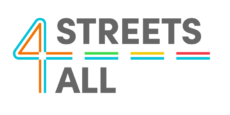work packages
STREETS4ALL is organized in 6 main work packages
We will review the state-of-practice and the off-the-shelve and forthcoming technological solutions for urban sensing and smart infrastructure technologies that can enable equitable and dynamic street space reallocation.
We will define aggregate criteria and guidelines to map the STREETS4ALL potential of cities over time (when is it more appropriate to change street functions?). We will apply the procedure to Lisbon, our case study. The potential urban areas for implementing STREETS4ALL solutions will belong to the urban space dedicated to mobility, whether it is a street, an avenue, or a square. Many criteria could determine the inclusion of such areas, such as vicinity to Points of Interest, the density and diversity of land-uses (following Cervero’s 3D planning approach), transportation infrastructures, or modes available.
After selecting the testbed sites, this task’s main objective is to characterize their current mobility patterns and uses of the public space (e.g., esplanades, strollers). We will collect the required data 24/7 over a typical week to model the behavior and acceptance of potential users of STREETS4ALL solutions and develop the microsimulation models in Task 4. The data collected will also feed the models to estimate energy and emission factors and evaluate users’ acceptance evaluation in Task 6. The aim is to provide insights into how different modal demands vary in the public space over time and how they might change after STREETS4ALL implementation.
Task 4 is a creative task that will follow a design thinking approach, inspired by the Design School at Stanford. The main objective is to design the most diversified set of possible solutions of equitable and dynamic reallocation of street space based on the testbeds selected in Task 3. Based on the street activity levels of all modes processed in Task 3, we will begin by identifying the day and week periods where equitable and dynamic road space reallocation is possible in each testbed site. A day of traffic in a city can be divided into relatively stable periods (e.g., peak and off-peak periods). Notwithstanding, other divisions may arise depending on the indicators chosen for such classification and on the case-studies selected. After determining the time windows for potential reallocation of street space, we will begin the Design Thinking procedure for each testbed.
This task’s objective is to evaluate each testbed’s most appropriate solutions from Task 4. We will define the criteria for selecting solutions that experts and stakeholders will determine in a focus group activity. Besides, the criteria will be weighted with a Multicriteria Assessment (MCA). The focus group activity will include mobility and urban planners from the municipality, private companies (including our partner Siemens), and public entities (e.g., metro and bus operators). The criteria will include mobility and accessibility indicators (e.g., LoS of all modes, travel times, delays, access to land uses, walkability, bikeability, active accessibility). To feed these indicators, we will estimate the impacts on all modes’ accessibility (e.g., connectivity, betweenness, walkability, cyclability) and mobility (e.g., travel times, delays, space per pedestrian) of the solutions proposed in Task 4.
For that, we will calibrate microsimulation models for the motorized traffic patterns of selected cases’ in Task 2, based on the data collected over the 24/7 period in Task 3, including up and downstream intersections and the surrounding areas where traffic spillovers could occur due to capacity reduction in the studied segments. Then, we will simulate the impact of street space reallocation of each tested solution on the traffic patterns.
The main objectives of task 6 are twofold: the evaluation of the energy, environmental and health impacts of STREETS4ALL solutions and the technological acceptance by potential users. The concept of street space reallocation will lead to different mixes of transport modes and diverse driving conditions. The changes in mobility patterns will result in different outcomes in energy consumption and local (PM, CO, NOx, HC) and global pollutants (CO2, N2O, CH4). The analyses proposed here typically address tailpipe impacts (Tank-to-Wheel stages) but can be expanded to a Life Cycle Assessment (LCA).
The second part of this task is to analyze the technological acceptance of dynamic road/street space allocation. Typically, two primary factors influence an individual’s intention to use new technology: perceived ease of use and perceived usefulness. A senior who perceives ITS as too challenging to adapt to will be unlikely to adopt this technology. Conversely, a senior who perceives the same technology as bringing additional comfort and safety in the use of the public space will be more likely to learn how to use and adopt it. We will develop an acceptance model to new urban technological applications that will most certainly arise more often within the Smart Cities evolutionary context. Based on our previous experience, the technology acceptance evaluation will be based on thorough interviews with experts and focus group activities with stakeholders to analyze the potential barriers for different population segments, besides the street intercept interviews.
- Starting Soon
- In Progress
- Finished
